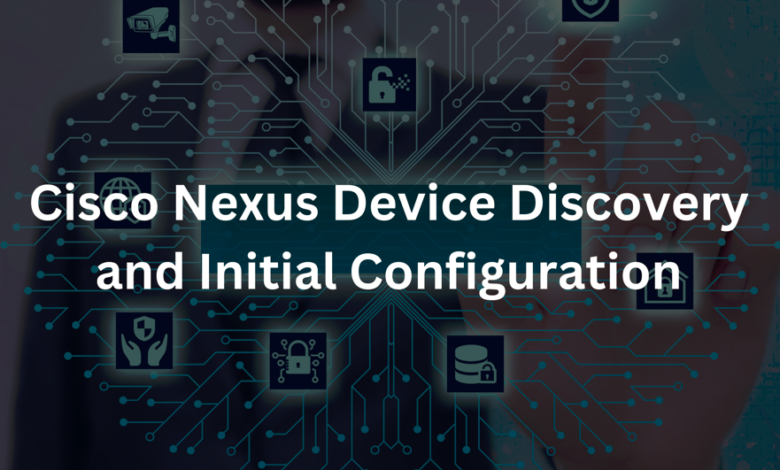Cisco Nexus Device Discovery and Initial Configuration

Cisco Nexus devices are certainly the part and parcel of the so called ‘modern’ data centres that enhance efficiency and provide avenues for scaling cloud-centric architectures and making it relatively simple with ACI installations. It is obvious that Nexus switches are made for selective usage to the engineers due to the reasons of their deployment which explains the need of efficient networks management.
Cisco ACI Training will describe deployments, configurations, and control of Cisco Nexus devices, and additional configurations like ACI Tenants, Contexts, Bridge Domains among others. These substances are very important in actualization of better management strategies, and perfect training in Cisco ACI management will be important because of these problems in today’s multi-tenant data centers.
Initial Configuration Steps:
- Connect via Console/Management Port: Start by connecting to the Nexus switch through the console or management interface.
- Assign Management IP: Configure a management IP address to access the device remotely.
- Enable SSH: Securely manage the switch by enabling SSH for encrypted remote connections.
- Set Basic Settings: Set the hostname, domain name, and time zone to establish a basic identity for the device.
- Create User Credentials: Configure admin credentials for logging into the device.
- Verify Device Status: Use the show version command to verify the software version and check the health of the device.
- Neighbor Discovery with CDP: Cisco Discovery Protocol (CDP) helps identify neighboring Cisco devices connected to the Nexus switch.
Best Practices:
- Keep the Nexus OS updated to the latest stable release for better performance and security.
- Implement access control by restricting management interface access to trusted IP addresses.
- Regularly back up configuration files to prevent data loss during unexpected issues.
See also: How to File a Car Insurance Claim: A Step-by-Step Guide
Device HealthScore Deep Dive
Cisco ACI provides a HealthScore system to monitor the operational status and performance of network devices, including Nexus switches. A perfect score of 100 signifies optimal performance, while lower scores indicate potential issues that need to be addressed. Monitoring the HealthScore helps in proactive troubleshooting, minimizing downtime, and improving network reliability.
Key Factors Impacting Device HealthScore:
- Interface Errors: CRC errors, packet drops, and collisions negatively affect the health score.
- CPU & Memory Utilization: High CPU or memory utilization can strain the device and lower the health score.
- Environmental Issues: Temperature fluctuations, power supply issues, or hardware failures may degrade the health score.
Monitoring HealthScore in Cisco ACI:
- Access the “Health Scores” section in the ACI GUI to view a detailed score breakdown.
- Drill down into specific devices and interfaces to identify root causes of performance degradation.
- Set up automated alerts to receive notifications when a device’s health score drops below a predefined threshold.
Topology Section and Interface Statistics
The Topology section in Cisco ACI provides a graphical overview of the network, making it easier to visualize the connections between Nexus devices and other network components. It shows leaf and spine switches, endpoints (such as virtual machines), and the links between them. Understanding and analyzing interface statistics is crucial to ensuring the proper functioning of each link in the network.
Interface Statistics:
- Traffic Load: Shows the amount of data passing through each interface, helping in load balancing and capacity planning.
- Error Metrics: Helps identify faulty cables, interface misconfigurations, or port errors by tracking CRC errors, packet drops, and interface resets.
- Bandwidth Utilization: Provides insights into the traffic load on each interface and whether it’s approaching maximum capacity.
Useful Commands:
- show interface: Provides detailed interface-level statistics for monitoring errors and traffic load.
- show topology: Displays a visual representation of connected devices and network paths.
What are Tenants, Contexts, and Bridge Domains in ACI?
These are key components of Cisco ACI architecture, providing logical segmentation and routing capabilities within the network. Understanding these constructs is critical for designing and managing an ACI-based network.
- Tenant: A Tenant is a logical unit that represents an isolated network environment within ACI. It allows for segmentation between different departments, customers, or applications. Each Tenant can have its own policies, configurations, and resources, ensuring complete isolation.
- Context (VRF): Virtual Routing and Forwarding (VRF) instances are created within a Tenant. A VRF provides isolated routing tables, allowing different Tenants to have independent network configurations, even if they use overlapping IP address spaces.
- Bridge Domain (BD): A Bridge Domain is a Layer 2 network that forwards traffic between endpoints. Each Bridge Domain can be associated with one or more subnets and allows Layer 2 communication within the network. It also supports Integrated Routing and Bridging (IRB), allowing for Layer 2 and Layer 3 communication within the same domain.
| Term | Definition | Use Case |
| Tenant | Logical container for isolating network resources. | Multi-tenant environments. |
| Context (VRF) | Separate routing table for different Tenants or departments. | Segmented routing within a Tenant. |
| Bridge Domain (BD) | Layer 2 forwarding construct for connecting endpoints. | Isolating Layer 2 traffic. |
| IRB | Cross-layer 2 and Layer 3 communication bridging and integrated routing. | Allows routing between networks. |
| HealthScore | metric that shows how well network devices are performing and how healthy they are. | Monitoring the effectiveness of the device. |
| Topology Section | Visual representation of the physical and logical network layout. | Network visualization and troubleshooting. |
Conclusion
Today the management of modern networks is impossible without Cisco Nexus devices and the ACI framework. The very first and obviously precise and unusually advantageous deployment of Nexus switches including Nexus ACI Tenants, Contexts, and Bridge Domains makes is possible to create cost-less controlled and extensible multi-tenant networks. HealthScore system and visualization of topology helps also maintain network health.
After understanding these and these configurations, networks—even the most complex data center could be administrated smart. Make haste to enroll on the Cisco ACI course so as to acquire more knowledge and develop adequate network structures.




